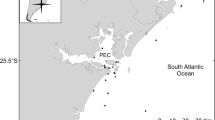Abstract
The exact timing ofAnguilla japonica spawning was determined from analyses of daily otolith increments in leptocephali collected near a spawning area west of the Mariana Islands on July 1–18, 1991. The birth dates of the 54 leptocephali examined (10.2 to 30.5 mm in total length) ranged from May 22 to June 24, 1991, the individuals clearly comprising two age groups, May-born fish (mode May 28) and June-born fish (mode June 21). The data showed thatA. japonica spawns intermittently during the spawning season, with fixed synchronized timing. Each group of leptocephali collected along three different north-south transects (131°, 134° and 137°E between 10° and 22°N) comprised both May-born and June-born fish. The latter were dominant along the easternmost and middle transects, whereas the May-born fish were more abundant along the westernmost transect. The modal ages of the June-born and May-born fish collected along 137°E on July 1–3 were 13 d and 35 d, respectively, while those of the two age groups collected along 134°E on July 17 and 18 were 28 d and 50 d, respectively. These data show that the interval between the sampling dates for the two transects (ca. 15 d) corresponded closely to the differences in modal ages of specimens from the two transects (15 d) for both the May- and June-born fish, and further, that the difference in modal age between the two age groups (22 d) was the same at both transects. A similar correspondence in total length was also observed between the two age groups at the above two transects. The findings clearly demonstrated parallel westward transport by the North Equatorial Current for both the May- and June-born eel leptocephali, which originated from a spawning area estimated as being between 141° and 143°E.
Similar content being viewed by others
Literature Cited
Kimura, S., K. Tsukamoto and T. Sugimoto. 1994. A model for the larval migration of the Japanese eel: roles of the trade winds and salinity front. Mar. Biol. 119: 185–190.
McCleave, J. D. and G. S. Wippelhauser. 1987. Behavioral aspects of selective tidal stream transport in juvenile American eels. American Fisheries Society Symposium, 1: 138–150.
Mochioka, N. 1996. Morphology and growth of Japanese cel larvae. Pages 22–32in O. Tabeta, ed. Early life history and prospects of seed production of the Japanese eelAnguilla japonica. Kouseisya-Kouseikaku. Tokyo.
Schmidt, J. 1925. The breeding places of the eel. Annual Report of the Smithsonian Institution, 1924: 279–316.
Thresher, R. E. 1991. Geographic variability in the ecology of coral reef fishes: evidence, evolution, and possible implications. Pages 401–436,in P. F. Sale, ed. The ecology of fishes on coral reefs. Academic Press, San Diego.
Tsukamoto, K. 1990. Recruitment mechanism of the eel,Anguilla japonica, to the Japanese coast. J. of Fish Biol. 36: 659–671.
Tsukamoto, K., 1992. Discovery of the spawning area for Japanese eel. Nature, 356, 6372: 789-791.
Tsukamoto, K. 1994. The eel: establishment of their great migration. Pages 42–58in A. Goto, K. Tsukamoto and K. Maekawa, es. Freshwater fishes migrating between the freshwater and the sea. Tokai University Press, Tokyo.
Tsukamoto, K. 1996. Breeding places of freshwater eels. Pages 11–21in O. Tabeta, ed. Early life history and prospects of seed production of the Japanese eelAnguilla japonica. Kouseisya-Kouseikaku, Tokyo.
Tsukamoto, K., A. Umezawa, O. Tabeta, N. Mochioka and T. Kajihara. 1989. Age and birth date ofAnguilla japonica leptocephali collected in Western North Pacific in September 1986. Nippon Suisan Gakkaishi, 55: 1023–1028.
Tsukamoto, K., A. Umezawa and T. Ozawa. 1992. Age and growth ofAnguilla japonica leptocephali collected in Western North Pacific in July 1990. Nippon Suisan Gakkaishi, 58: 457–459.
Umezawa, A., K. Tsukamoto, O. Tabeta and H. Yamakawa. 1989. Daily growth inerements in the larval otolith of the Japanese eel,Anguilla japonica. Japan. J. Ichthyol., 35: 440–444.
Yamamoto, K. and K. Yamauchi. 1974. Sexual maturation of Japanese eel and production of eel larvae in the aquarium. Nature, 251: 220–222.
Yamamoto, K., K. Yamauchi and S. Kasuga. 1975. On the development of the Japanese eel,Anguilla japonica. Nippon Suisan Gakkaishi, 41: 21–28.
Author information
Authors and Affiliations
About this article
Cite this article
Tsukamoto, K., Lee, TW. & Mochioka, N. Synchronized spawning ofanguilla japonica inferred from daily otolith increments in leptocephali. Ichthyological Research 45, 187–193 (1998). https://doi.org/10.1007/BF02678561
Received:
Revised:
Accepted:
Issue Date:
DOI: https://doi.org/10.1007/BF02678561




